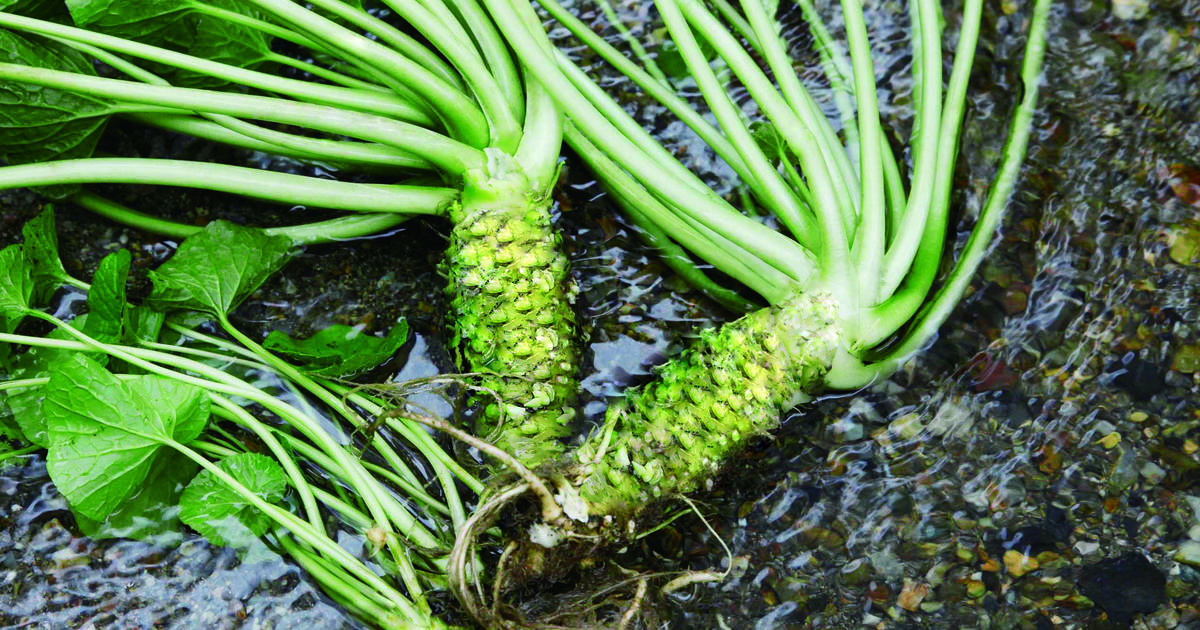- cross-posted to:
- hackernews@derp.foo
- food

The Tohoku University study was published in the journal Nutrients. A wasabi company, Kinjirushi Co., provided funding, though the researchers say the company had no role in the study itself.
Yeah, that study is worthless.

Not necessarily disagreeing with you but almost all studies are funded by private companies.

Usually by someone with a financial interest in seeing that the study yelds a result that is beneficial for them.

Of course

Surely this depends on the field? In life sciences it is quite uncommon. Food science, sure…

Just know you’ll never get real wasabi, except in the highest end places in Japan and probably still special order. The stuff we get is fake.

yea this stuff really needs better regulations so 0.1% real wasabi cant be advertised like one
Not really. Most sushi places have them (not kaitenzushi), some bbq place do too and you can buy it at the supermarket:
https://kitanosansai.ocnk.net/phone/product/13
Most sushi places in Japan? At least in the US, I’ve only ever gotten dyed green Wasabi except in Hawaii.
Edit: Realized I meant to say “dyed green horseradish”
Wasabi roots are common in Japan and while there are pricing variations, it’s not as expensive as its told here.
Plus you can grow them in the US as well (see below).As far as I understood temperature and water quality were very important, but it seems that isn’t that hard to grow some on a pot:
https://www.thespruce.com/growing-wasabi-plants-5082985In the description says that “You won’t be able to harvest the rhizomes of most wasabi plants until the second year”, so that’s a lot of waiting for it.
TIL even Wasabi is in the brassica family.

Here’s the study, for anyone who wants to read it. It’s surprisingly short and open access.
A few things:
The participants took Wasabi supplements once a day for 12 weeks, not just normal Wasabi. In each pill, there was 0.8 mg of the active compound (6-MSITC). Quick googling gave me the following for the level of that compound in actual Wasabi:Another study determined ~550-556 μg/g of 6-MSITC in wet weight of wasabi root [10] . The present study observed a concentration of 120-150 μg/g wet weight of 6-MSITC in stem and rhizome blend.
In other words, you could actually also get the same amount of 6-MSITC that was in the supplements by eating a few grams of regular wasabi each day, assuming that the processed stuff still has similar levels. The abstract provides a reasonable summary of the study, and of the fact that it agrees largely with some previous science on the subject (although there’s not a lot, two studies in small journals):
Cognitive functions decline with age. Declined cognitive functions negatively affect daily behaviors. Previous studies showed the positive effect of spices and herbs on cognition. In this study, we investigated the positive impact of wasabi, which is a traditional Japanese spice, on cognitive functions. The main bioactive compound of wasabi is 6-MSITC (6 methylsulfinyl hexyl isothiocyanate), which has anti-oxidant and anti-inflammatory functions. Anti-oxidants and anti-inflammatories have an important role in cognitive health. Therefore, 6-MSITC is expected to have positive effects on cognitive function. Previous studies showed the beneficial effects on cognitive functions in middle-aged adults. However, it is unclear that 6-MSITC has a positive effect on cognitive functions in healthy older adults aged 60 years and over. Here, we investigated whether 12 weeks’ 6-MSITC intervention enhances cognitive performance in older adults using a double-blinded randomized controlled trial (RCT). Methods: Seventy-two older adults were randomly assigned to 6-MSITC or placebo groups. Participants were asked to take a supplement (6-MSITC or a placebo) for 12 weeks. We checked a wide range of cognitive performances (e.g., executive function, episodic memory, processing speed, working memory, and attention) at the pre- and post-intervention periods. Results: The 6-MSITC group showed a significant improvement in working and episodic memory performances compared to the placebo group. However, we did not find any significant improvements in other cognitive domains. Discussion: This study firstly demonstrates scientific evidence that 6-MSITC may enhance working memory and episodic memory in older adults. We discuss the potential mechanism for improving cognitive functions after 6-MSITC intake.
They tested the study participants once before and once after the 12 weeks of daily wasabi supplements. The participants were not tested for any long term cognitive effects.
As someone else has pointed out here in the comments, the study does list a Wasabi company as one of the sources of funding:
Funding
This study was founded[sic] by KINJIRUSHI Co., Ltd. and the Japan Society for the Promotion of Science (19H01760, 22H01088).
Conflicts of Interest
This study was supported by KINJIRUSHI Co., Ltd. The funding body had no role in the design of the study, collection, analyses, or interpretation of the data, writing of the manuscript, or the decision to publish the results.Also, I don’t want to poison the well too much, but I feel like I should mention that the editorial board of the journal resigned in 2018 because the publishers “pressured them to accept manuscripts of mediocre quality and importance”. Doesn’t mean it’s all bad, but it’s a very early study and more research should be done.
- shiveyarbles ( @shiveyarbles@beehaw.org ) 5•1 year ago
I read that most store bought wasabi isn’t the real stuff, just an fyi
Yeah, it mentions this at the end of the article:
But here’s the rub: That tangy paste served up at nearly all sushi bars — even the ones in Japan — is almost certainly an impostor. Far more common than the real thing is a convincing fraud, usually made of ordinary white horseradish, dyed green.
Native to Japan, wasabi is notoriously difficult to cultivate. The plant takes nearly two years to reach maturity and requires exacting temperature, shade, gravel and water conditions. It can cost more per pound than even the choice tuna it sits on.
Genuine wasabi must be consumed fresh, with the stubbly rhizome, or stem of the plant, grated tableside just before eating. On the plus side, just a small dab offers the same benefits as the capsule supplements used in the Tohoku study, or 0.8 milligrams of 6-MSITC.

I wonder if it will work with the fake Wasabi that is all over outside of Japan, that’s horseradish based. The chemical of the “spicy” part is the same, I believe. But getting real Wasabi anywhere in the states is expensive and has a shorter shelf life.
*Horseradish doesn’t have any. So you’ll have a harder time getting the 6-MSITC, but im sure they’ll quickly be a supplement to buy.

It used to be that real wasabi only grew in Japan, though they started growing it in England and Iceland some years ago, so availability may improve. Though with its short shelf life, the stuff you get outside of specialist grocers and high-end restaurants will be a cheaper and hardier variety of horseradish.

It seems like it’s being grown in a lot of places now. Many people in this thread have mentioned Oregon (USA), and I know it’s also being grown in Tasmania (Australia).

There’s one location on the Oregon coast that grows it in small quantities. They serve it at Zilla Sake in Portland.

“The main active component of Japanese wasabi is a biochemical called 6-MSITC, a known antioxidant and anti-inflammatory known to exist in only trace amounts elsewhere throughout the plant kingdom, Nouchi said. The double-blind, randomized study involved 72 healthy subjects, aged 60 to 80. Half of them took 100 milligram s of wasabi extract at bedtime, with the rest receiving a placebo.”
This is the best summary I could come up with:
Researchers at Tohoku University found that wasabi, that spicy green condiment traditionally dabbed on the raw fish dish, improves both short- and long-term memory.
Rui Nouchi, the study’s lead researcher and an associate professor at the school’s Institute of Development, Aging and Cancer, told CBS News the results, while based on a limited sample of subjects without preexisting health conditions, exceeded their expectations.
The main active component of Japanese wasabi is a biochemical called 6-MSITC, a known antioxidant and anti-inflammatory known to exist in only trace amounts elsewhere throughout the plant kingdom, Nouchi said.
The researchers theorized that 6-MSITC reduces inflammation and oxidant levels in the hippocampus, the area of the brain responsible for memory function, and boosts neural plasticity.
The fiery condiment paste made with it became prized in Japan centuries ago for its antimicrobial properties, which make it capable of killing off foodborne pathogens such as E-coli and staphylococcus, while its flavor and aroma complemented seafood.
A specialist in dementia prevention, Nouchi landed on wasabi treatment after finding high dropout rates with conventional methods of preserving brain health, such as the Mediterranean diet, exercise and music therapy.
The original article contains 623 words, the summary contains 189 words. Saved 70%. I’m a bot and I’m open source!

Well, I use wasabi to clear my sinuses.
And that feeling is certainly memorable.


